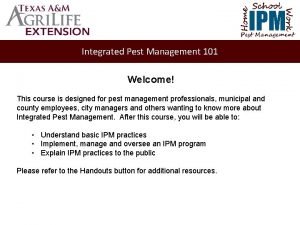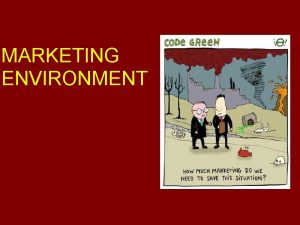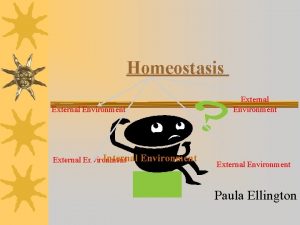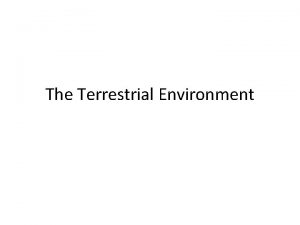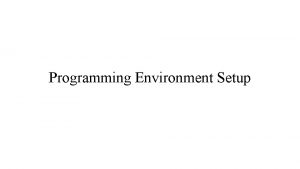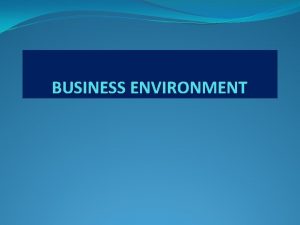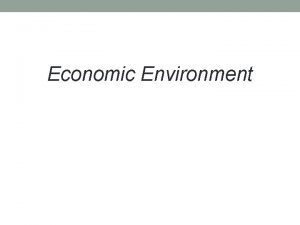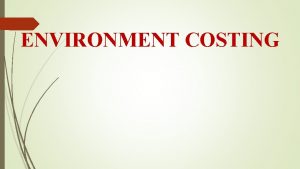Chapter 1 The Office Environment The Office Environment





















- Slides: 21

Chapter 1 The Office Environment

The Office Environment 1 -1 The Office Today 1 -2 The Office in Relation to the Total Organization 1 -3 Your Role in an Office

1 -1 The Office Today Objectives 1 -1 a Describe the purpose of an office and office activities. 1 -1 b Explain how technology influences office practices. 1 -1 c Describe alternative offices.

Key Terms • • • office information vendor World Wide Web intranet telecommuting Internet virtual office hoteling freelancer

Purpose of an Office • An office is a place in which the affairs of an individual, a business, or an organization are carried out. • Offices Are Information Driven – Information is data or facts that have been organized in a meaningful form. – A vendor is a seller of goods or services. • Office Functions Are Varied

Key Office Activities 1. 2. 3. 4. 5. Creating/Analyzing Information Searching for Information Processing Information Communicating Information Managing Information

Technology in Modern Offices • World Wide Web refers to resources on the Internet that support hyperlinks, text, graphics, and multimedia. • Intranet is a private computer network that looks and operates similar to web pages.

Alternative Offices • Telecommuting is the practice of working and communicating with others from a home office or other remote location. • Internet is a public, world-wide computer network that spans the globe. • Virtual Office – Virtual office is a setting that allows you to perform work activities as you would in a traditional office. • Mobile Office – Hoteling is using workspace that is assigned as needed.

Alternative Offices (continued) • Home Office – A freelancer is an independent contractor who works for others for a project fee or hourly fee.

1 -2 The Office in Relation to the Total Organization Objectives 1 -2 a Describe common types of businesses and other organizations. 1 -2 b Identify goals for different types of organizations. 1 -2 c Describe a common structure for personnel in an organization.

Key Terms • • • profit sole proprietorship partnership corporation income statement empowerment

Types of Organizations • Businesses – A profit is monetary gain, advantage. – Sole Proprietorship • A sole proprietorship is a business owned by one individual. – Partnership • A partnership is a business that is not incorporated and has two or more owners. – Corporation • A corporation is a business set up under the laws of a particular state. – Limited Liability Company

Types of Organizations (continued) • Not-for-Profit Entities • Government Units

Goals of Organizations • Businesses – An income statement is a document that shows profit or loss for a business for a certain period of time. • Not-for-Profit and Governments

Structure of Organizations • Board of Directors • Management Employees • Department Employees • Empowerment is being able to make decisions or changes without seeking approval.

1 -3 Your Role in an Office Objectives 1 -3 a Discuss the behaviors and attitudes of an office professional. 1 -3 b Recognize the importance of having a customer focus. 1 -3 c Describe strategies for working effectively in teams.

Key Terms • • professional work ethic cooperative confidential customer focus empathy goodwill

Office Professionals • A professional is someone who conforms to expected ethical and quality standards and behaviors. • Work Ethic – Work ethic is a value system that places importance on work or other purposeful activity. • Cooperation – A cooperative worker is willing to participate in what needs to be done to achieve a goal. – Loyalty – Continued Learning

Office Professionals (continued) • Interacting with Coworkers – Confidentiality • Confidential is something private or secret. – Sharing Information – Accepting Responsibility for Mistakes

Customer Focus • A customer is someone who buys or uses an organization’s products or services. • Customer focus is paying attention to fulfilling the needs and wants of customers. • External and Internal Customers • Customer Service Strategies – Empathy is understanding or concern for someone’s feelings or position. – Goodwill is a friendly or kindly attitude.

Working Effectively in Teams • Working as a team, employees bring varying experiences, observations, insights, and knowledge to tasks. • A team, thinking critically, can be far more successful than an individual working alone. • For a team to be successful, its members must be reliable in carrying out their responsibilities, and they must be committed to the team and its goals.
 Financial environment of business
Financial environment of business Cultural ipm
Cultural ipm Hình ảnh bộ gõ cơ thể búng tay
Hình ảnh bộ gõ cơ thể búng tay Lp html
Lp html Bổ thể
Bổ thể Tỉ lệ cơ thể trẻ em
Tỉ lệ cơ thể trẻ em Chó sói
Chó sói Thang điểm glasgow
Thang điểm glasgow Hát lên người ơi
Hát lên người ơi Kể tên các môn thể thao
Kể tên các môn thể thao Thế nào là hệ số cao nhất
Thế nào là hệ số cao nhất Các châu lục và đại dương trên thế giới
Các châu lục và đại dương trên thế giới Công thức tiính động năng
Công thức tiính động năng Trời xanh đây là của chúng ta thể thơ
Trời xanh đây là của chúng ta thể thơ Mật thư anh em như thể tay chân
Mật thư anh em như thể tay chân 101012 bằng
101012 bằng Phản ứng thế ankan
Phản ứng thế ankan Các châu lục và đại dương trên thế giới
Các châu lục và đại dương trên thế giới Thơ thất ngôn tứ tuyệt đường luật
Thơ thất ngôn tứ tuyệt đường luật Quá trình desamine hóa có thể tạo ra
Quá trình desamine hóa có thể tạo ra Một số thể thơ truyền thống
Một số thể thơ truyền thống Cái miệng bé xinh thế chỉ nói điều hay thôi
Cái miệng bé xinh thế chỉ nói điều hay thôi

